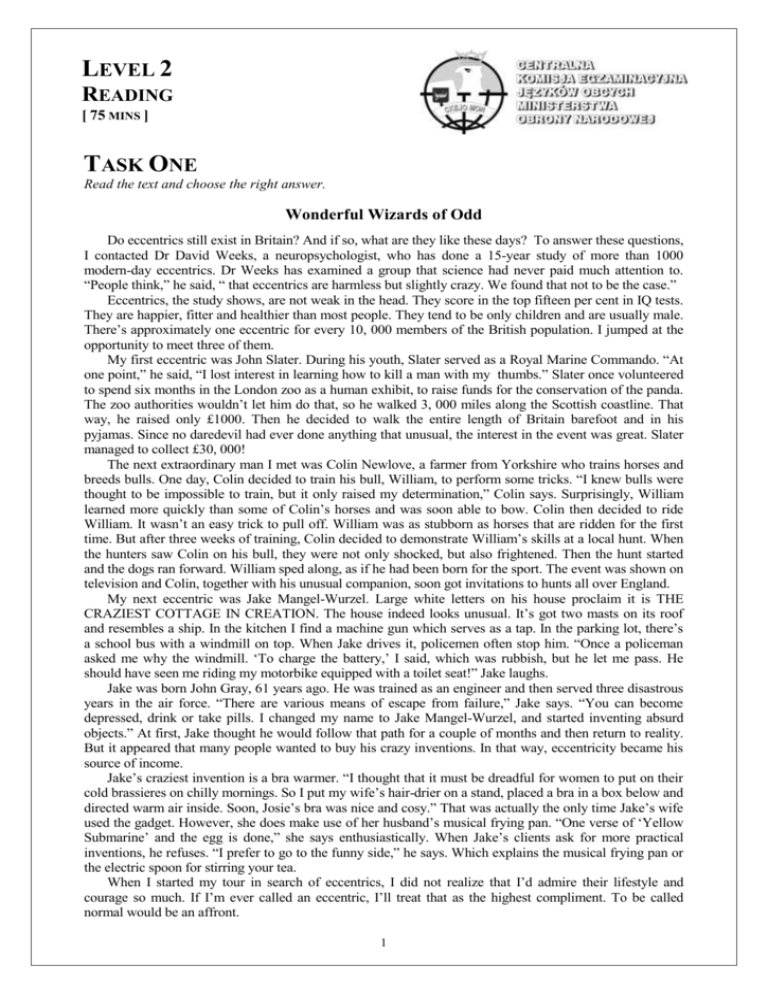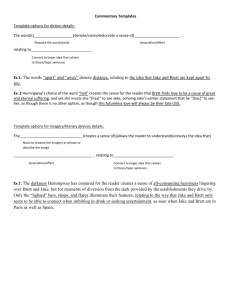Task One
advertisement

LEVEL 2 READING [ 75 MINS ] TASK ONE Read the text and choose the right answer. Wonderful Wizards of Odd Do eccentrics still exist in Britain? And if so, what are they like these days? To answer these questions, I contacted Dr David Weeks, a neuropsychologist, who has done a 15-year study of more than 1000 modern-day eccentrics. Dr Weeks has examined a group that science had never paid much attention to. “People think,” he said, “ that eccentrics are harmless but slightly crazy. We found that not to be the case.” Eccentrics, the study shows, are not weak in the head. They score in the top fifteen per cent in IQ tests. They are happier, fitter and healthier than most people. They tend to be only children and are usually male. There’s approximately one eccentric for every 10, 000 members of the British population. I jumped at the opportunity to meet three of them. My first eccentric was John Slater. During his youth, Slater served as a Royal Marine Commando. “At one point,” he said, “I lost interest in learning how to kill a man with my thumbs.” Slater once volunteered to spend six months in the London zoo as a human exhibit, to raise funds for the conservation of the panda. The zoo authorities wouldn’t let him do that, so he walked 3, 000 miles along the Scottish coastline. That way, he raised only £1000. Then he decided to walk the entire length of Britain barefoot and in his pyjamas. Since no daredevil had ever done anything that unusual, the interest in the event was great. Slater managed to collect £30, 000! The next extraordinary man I met was Colin Newlove, a farmer from Yorkshire who trains horses and breeds bulls. One day, Colin decided to train his bull, William, to perform some tricks. “I knew bulls were thought to be impossible to train, but it only raised my determination,” Colin says. Surprisingly, William learned more quickly than some of Colin’s horses and was soon able to bow. Colin then decided to ride William. It wasn’t an easy trick to pull off. William was as stubborn as horses that are ridden for the first time. But after three weeks of training, Colin decided to demonstrate William’s skills at a local hunt. When the hunters saw Colin on his bull, they were not only shocked, but also frightened. Then the hunt started and the dogs ran forward. William sped along, as if he had been born for the sport. The event was shown on television and Colin, together with his unusual companion, soon got invitations to hunts all over England. My next eccentric was Jake Mangel-Wurzel. Large white letters on his house proclaim it is THE CRAZIEST COTTAGE IN CREATION. The house indeed looks unusual. It’s got two masts on its roof and resembles a ship. In the kitchen I find a machine gun which serves as a tap. In the parking lot, there’s a school bus with a windmill on top. When Jake drives it, policemen often stop him. “Once a policeman asked me why the windmill. ‘To charge the battery,’ I said, which was rubbish, but he let me pass. He should have seen me riding my motorbike equipped with a toilet seat!” Jake laughs. Jake was born John Gray, 61 years ago. He was trained as an engineer and then served three disastrous years in the air force. “There are various means of escape from failure,” Jake says. “You can become depressed, drink or take pills. I changed my name to Jake Mangel-Wurzel, and started inventing absurd objects.” At first, Jake thought he would follow that path for a couple of months and then return to reality. But it appeared that many people wanted to buy his crazy inventions. In that way, eccentricity became his source of income. Jake’s craziest invention is a bra warmer. “I thought that it must be dreadful for women to put on their cold brassieres on chilly mornings. So I put my wife’s hair-drier on a stand, placed a bra in a box below and directed warm air inside. Soon, Josie’s bra was nice and cosy.” That was actually the only time Jake’s wife used the gadget. However, she does make use of her husband’s musical frying pan. “One verse of ‘Yellow Submarine’ and the egg is done,” she says enthusiastically. When Jake’s clients ask for more practical inventions, he refuses. “I prefer to go to the funny side,” he says. Which explains the musical frying pan or the electric spoon for stirring your tea. When I started my tour in search of eccentrics, I did not realize that I’d admire their lifestyle and courage so much. If I’m ever called an eccentric, I’ll treat that as the highest compliment. To be called normal would be an affront. 1 1. Dr Weeks’s research … A. analysed nearly 1000 eccentric people B. was the first deep study of eccentrics C. showed eccentrics were a little mad 2. Eccentrics usually … A. score badly in IQ tests B. are in better form than others C. have many brothers and sisters 3. To collect money Slater … A. became a human exhibit in the London zoo B. walked across Scotland with no shoes on C. walked through Britain in unusual clothes 4. William was … A. invited to hunts all around England B. harder to ride at first than horses C. shocked and scared at his first hunt 5. Once a policeman stopped Jake when he was … A. riding his motorbike B. recharging his battery C. driving his school bus 6. After his service in the Army, Jake … A. took to heavy drinking and taking pills B. earned money by doing what he loved C. finally stopped behaving eccentrically 7. Jake’s wife … A. uses the bra warmer on chilly mornings B. often prepares food with the musical pan C. asks Jake to invent more useful objects 2 Task Two In this task six phrases have been removed from the text and placed at the bottom. An extra phrase has been included. You must decide which phrase goes into which gap and write the right letter in the box below the sentences. An example has been done for you. Cyberspace Plans According to Pentagon officials, the United States needs … (0) … , so that it can strike enemy targets more effectively. All these changes are necessary if … (8) … against the growing danger from cyber weapons and tactics. In case of a cyber attack, the decision process is not going to last minutes, claims Gen. James Cartwright, chief of the U.S Strategic Command (STRATCOM). He goes on to explain that decision-making in the future … (9) … . U.S enemies, like al-Qaida and potential rivals like China, have shown what they can do in cyberspace, according to information security experts. They agree that trend is not going to slow down in the coming years, and this causes panic … (10) … . Cartwright himself admitted during an industry conference in Alexandria that the U.S. is not always winning in the race to keep pace with enemies’ cyber tactics. Defense experts are becoming more and more interested in the virtual battlefield. The 2006 Defense Review said that cyberspace … (11) … in U.S. military operations. In November, the Air Force decided to form its first Cyberspace Command. Blue-suited officials expect one day it will become a major command. Officials in Washington and other military organizations like STRATCOM are discussing … (12) … – from a legal and hardware point of view – for cyber conflict. Pentagon officials realize that Washington has a lot to lose. Cartwright said during an Air Force conference in Florida, that over 90 percent of American business is online. “The reality is that we run our businesses there as a nation. Almost all of our trade is done in cyberspace,” he added. Cartwright and other military officials feel … (13) … cyber enemies. “We cannot be left behind,” the STRATCOM chief said. “We must also fight in that environment.” … A … (Example) to make changes in policy and training … B … is playing a more and more important role … C … the U.S. must be better able to strike … D … among all the members of the defense community … E … is going to take microseconds … F … how the military should be organized and armed … G … how equipment was protected … H … the U.S. wants to defend its computer networks 0 8 9 10 A 3 11 12 13 TASK THREE Read the text and write if the statements from 14 to 20 are true (T) or false (F). Portrait of a Perfect Murder Most murderers are unaware of even the simplest clues that might get them caught. However, is the "perfect" murder possible? To find out, we need to think like a Crime Scene Investigator (CSI). The so-called perfect murder – an undetectable crime where the killer is not caught – has long been the stuff of mystery fiction. From ice to legs of lamb, authors have tried to come up with more imaginative weapons and crimes. But would any of these clever methods work? Making a death look like an accident is one of the first things a murderer might try. But when a pathologist examines the body of the victim they're not just looking for the cause of death. Other minor injuries – like bruising from a struggle, or scratch marks where a body has been dragged – can show that a person has been murdered. The body can reveal a lot of secrets, so a number of killers have tried to get rid of their victim's body altogether. In the 1940s the "acid bath murderer" John Haigh tried to dissolve the bodies of six victims in sulphuric acid. This destroys bones and tissue but it can't digest fats or plastic. This is how John Haigh was caught. A pair of false teeth and a red plastic handbag, were found in acid at his workshop. But there is a weapon that wouldn't leave visible evidence behind. It's the professional killer’s favourite – poison. The victim may not even know what's happened until the murderer is many miles away. The most recent example is Alexander Litvinenko's poisoning with polonium in 2006. It took the investigators weeks to identify the poison, because polonium-210 had never been used in this way before. But what Litvinenko's poisoner may not have known is that this clever poison might also give them away. The alpha radiation given out by polonium-210 can be detected in incredibly small amounts. As the killer escaped, they were leaving behind a trail of evidence. This type of trace evidence is the final piece of the perfect murder puzzle. Modern crime scene investigators can find much more than just fingerprints. Although fingerprinting may seem oldfashioned, it is still used as much as it was in Sherlock Holmes’s days. Apart from that, the CSI team can detect tiny parts of clothing, footprints from a carpet, and of course DNA. A CSI team member, Ms Graham, says our DNA may actually make some of us better criminals than others. She explains how some people are more likely to leave their DNA than other people. One person could pick up a bottle of water, put it down; you get a full profile. Another one could drink from a bottle and you wouldn't pick up very much. No one knows exactly why this is, but there does seem to be a very big difference. But that's also why the real-life "perfect" murder is likely to fail. It relies too heavily on chance. Every single element must come together perfectly. The forensic scientists need just one mistake and the criminal could be caught. So, if someone wants to get away with murder, it is not enough to have the correct knowledge. Their best hope is to be very, very lucky. 0 (Example) Crime authors have used ice as a murder weapon. (…T..) 14. A pathologist is only interested in the reason for death. (……) 15. John Haigh successfully destroyed all the proof of the crime. (……) 16. Polonium is an unusual choice for professional killers. (……) 17. Polonium-210 can only be detected when there is a lot of it. (……) 18. Today fingerprints are less often used by investigators. (……) 19. Each person leaves different amounts of DNA on things they touch. (……) 20. The article says that a “perfect” murder is simple if you know what to do. (……) 4






